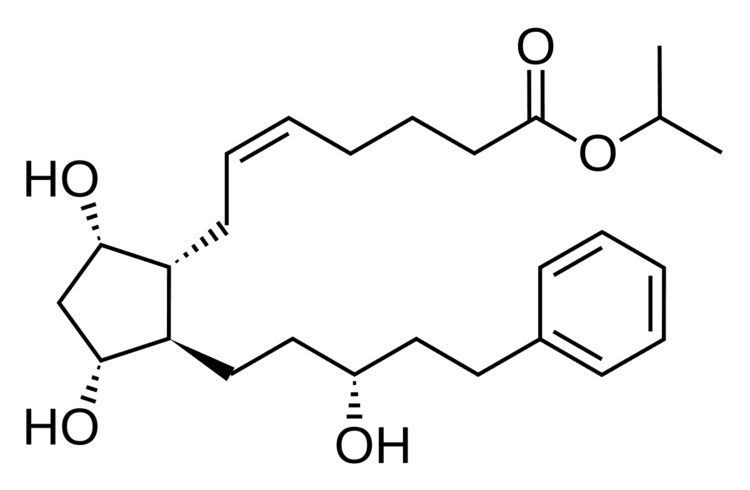Pronunciation la-TAN-oh-prost AHFS/Drugs.com Monograph Routes ofadministration Topical (eye drops) Molar mass 432.593 g/mol | Trade names Xalatan, others MedlinePlus a697003 CAS ID 130209-82-4 | |
 | ||
Pregnancycategory US: C (Risk not ruled out) | ||
Glaucoma drugs prostaglandin latanoprost pgf2a
Latanoprost, sold under the brand name Xalatan among others, is a medication used to treat increased pressure inside the eye. This includes ocular hypertension and open angle glaucoma. It is applied as eye drops to the eyes. Onset of effects is usually within four hours, and they last for up to a day.
Contents
- Glaucoma drugs prostaglandin latanoprost pgf2a
- Open angle glaucoma
- Closed angle glaucoma
- Adverse effects
- Pregnancy
- Interactions
- Mechanism of action
- Pharmacokinetics
- Stability
- Society and culture
- References
Common side effects include blurry vision, redness of the eye, itchiness, and darkening of the iris. Latanoprost is in the prostaglandin analogue family of medication. It works by increasing the outflow of aqueous fluid from the eyes through the uveoscleral tract.
Latanoprost approved for medical use in the United States in 1996. It is on the World Health Organization's List of Essential Medicines, the most effective and safe medicines needed in a health system. Latanoprost is available as a generic medication. The wholesale cost in the developing world is about 0.69 to 3.79 USD per 2.5 ml bottle. In the United States a month of treatment costs less than 25 USD.
Open-angle glaucoma
In people with ocular hypertension including open-angle glaucoma (IOP ≥21 mm Hg), treatment with latanoprost reduced IOP levels by 22 to 39% over 1 to 12 months’ treatment. Latanoprost was more effective than timolol 0.5% twice daily in 3 of 4 large (n = 163 to 267) randomised, double-blind trials. Latanoprost demonstrated a stable long-term IOP-lowering effect in 1- or 2-year continuations of these trials, with no sign of diminishing effect during prolonged treatment.
Meta-analysis suggests that latanoprost is more effective than timolol in lowering IOP. However, it often causes iris pigmentation. While current evidence suggests that this pigmentation is benign, careful lifetime evaluation of patients is still justified.
Closed-angle glaucoma
Patients who had elevated IOP despite iridotomy and/or iridectomy (including patients of Asian descent), latanoprost was significantly more effective than timolol in two double-blind, monotherapy trials (8.2 and 8.8 mm Hg vs 5.2 and 5.7 mm Hg for latanoprost vs timolol at 12 and 2 weeks, respectively).
Adverse effects
Listed from most to least common:
Pregnancy
Use in pregnant women is limited due to high incidence of abortion shown in animal experiments. Because of this, latanoprost is classified as risk factor C (adverse events were observed in animal reproduction studies at maternally toxic doses) according to United States Food and Drug Administration's use-in-pregnancy ratings. Drug excretion in breast milk is unknown.
Interactions
Interactions are similar to other prostaglandin analogs. Paradoxically, the concomitant use of latanoprost and bimatoprost or other prostaglandins may result in increased intraocular pressure. Non-steroidal anti-inflammatory drugs (NSAIDs) can reduce or increase the effect of latanoprost.
Mechanism of action
Like tafluprost and travoprost, latanoprost is an ester prodrug that is activated to the free acid in the cornea. Also like the related drugs, latanoprost acid is an analog of prostaglandin F2α that acts as a selective agonist at the prostaglandin F receptor. Prostaglandins increase the sclera's permeability to aqueous fluid. So, an increase in prostaglandin activity increases outflow of aqueous fluid thus lowering intraocular pressure.
Pharmacokinetics
Latanoprost is absorbed well through the cornea and completely hydrolysed to the active latanoprost acid. Highest concentrations of the acid in the aqueous humour are reached two hours after application, lowering of intraocular pressure starts after 3 to 4 hours, the highest effect is found after 8 to 12 hours, and its action lasts at least 24 hours. When latanoprost acid reaches the circulation, it is quickly metabolised in the liver by beta oxidation to 1,2-dinor- and 1,2,3,4-tetranor-latanoprost acid; blood plasma half life is only 17 minutes. The metabolites are mainly excreted via the kidney.
The activation and deactivation pathway is analogous to the one of tafluprost; see Tafluprost#Pharmacokinetics for chemical formulae.
Stability
Latanoprost exhibits thermal and solar instability. The concentration of latanoprost stored at 50 °C will decrease by 10% every 8.25 days. When stored at 70 °C the concentration will decrease by 10% every 1.32 days. Ultraviolet light, for example in sunlight, causes rapid degradation of latanoprost.
Society and culture
The brand Xalatan is manufactured by Pfizer and had annual sales of approximately $1.6 billion.
